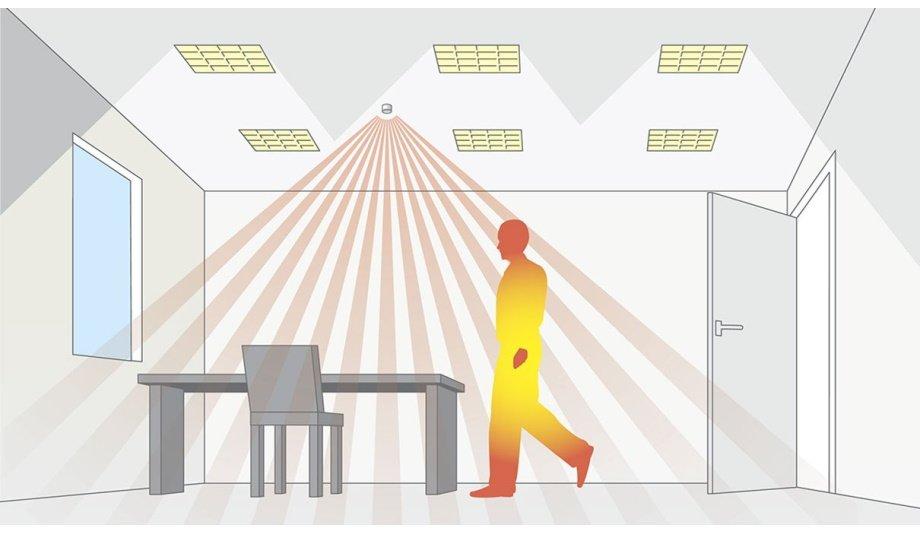Studies have confirmed the positive effects of artificial lighting on employee wellbeing. Steve Marr, the Director of Product at CP Electronics, part of Legrand’s Energy Controls business unit, explains how human centric lighting (HCL) and lighting control technology create more productive environments.
HCL focuses on light’s influence on circadian rhythms, the daily fluctuations of melatonin, cortisol and serotonin. Melatonin is a natural soporific produced in the evenings that helps us relax. In contrast, cortisol and serotonin make us mentally active, yet they are inhibited by melatonin.
HCL mimics natural daylight to boost health
Several studies have confirmed the effects of using artificial lighting to support circadian rhythms
The natural light spectrum affects the cycling of these hormones and HCL mimics natural daylight to boost health, well-being, attentiveness and productivity.
Several studies have confirmed the effects of using artificial lighting to support circadian rhythms. These effects show reduced accident risk, improved concentration and productivity, better visibility, and a general ‘uplift’ in feeling good.
Human centric lighting (HCL) system
According to the Building Research Establishment (BRE), Europeans spend around 90 percent of their time indoors, so emphasizing health and well-being is vital. As well as improving productivity, investing in a human centric lighting system will help cultivate highly motivated personnel with fewer absences.
A Gensler survey found that 90 percent of employees’ attitudes towards work are affected by their workplace environment. Irregular circadian rhythm has been linked to sleep disorders, obesity, diabetes, depression, bipolar disorder and seasonal affective disorder (SAD).
So how does it work? Human brains receive input from the eyes and send signals about the time of day to the bodies. In turn, circadian rhythm influences everything from body temperature and hormone release, to eating habits.
New and improved artificial lighting
While useful in commercial premises, HCL is also suitable for hospitals and schools
Despite improvements in LED technology, the primary reason for updating artificial lighting has been financial. However, the focus has recently shifted towards improving light quality and developing insights into light’s non-visual effects with specific attention directed at creating HCL solutions that mirror natural lighting as closely as possible.
While useful in commercial premises, HCL is also suitable for hospitals and schools. In hospitals, it can aid patient recovery by reinforcing a healthy circadian rhythm and in schools, it can help to create a better environment for learning and increased student alertness.
Correct LED luminaire specification
Correct LED luminaire specification is a significant piece of any HCL strategy, but it’s only part of the picture. When integrated with lighting control technology, the color temperature will adjust automatically, mimicking changes in natural light. This can be matched to the time of day and year.
Powerful, naturally bluish daylight suppresses melatonin, thereby supporting production of cortisol and serotonin, making people more alert. In the evenings, as daylight takes on a warmer hue, it stimulates melatonin production causing people to naturally wind down.
Controllable, adaptable lighting systems
Controllable, adaptable lighting systems create comfortable environments that can use blue frequencies to stimulate people, or relax them with amber and red. In addition, HCL can alter night shift workers' environments to improve their health and productivity.
The more closely natural sunlight is created in the environment, the better the light’s quality. The purpose of HCL is to mimic daylight and boost health, well-being, attentiveness and productivity. This is achieved by:
- Matching the light output of artificial light to the natural spectrum.
- Varying the composition of the spectrum throughout the day to mimic natural changes.
- Using wide, flat luminous surfaces analogous to the sky.
- Directing light from the upper visual hemisphere into the eye.
It is now possible to connect disparate building services, like heating, ventilation and lighting to create a complementary approach to comfort.
Installing a networked lighting control system
Installing a networked lighting control system, like CP Electronics’ RAPID, gives the user enhanced control
Installing a networked lighting control system, like CP Electronics’ RAPID, gives the user enhanced control. From the system head end, users can schedule color temperature and brightness patterns for specific areas or the entire building. They can schedule changes to maximize the calming or stimulating benefits they require.
However, HCL, well-being and quality of light, needs to be balanced with dimming control and energy efficiency. Here, the RAPID lighting control system offers users customizability. While the system can dictate color temperature, dimming via occupancy control and daylight linking can still be coordinated to reduce energy usage. Room occupants can even set their own preferences with manual overrides.
Deep impact
The European standard for lighting indoor workplaces, BS EN 12464, shows that lighting control should be the norm, not the exception. The standard addresses the design and development of lighting schemes around a specific activity and encourages designers to consider all lighting options. It provides guidelines for lighting controls and illuminating rooms only when in use.
The use of lighting control ensures compliance with Part L of the Building Regulations, requiring lights to be controlled or locally switched. Buildings that have lighting control systems demonstrate higher ratings in the Energy Performance Certificates and Display Energy Certificates owners and managers must have.
One step beyond
The benefits of lighting control extend far beyond energy efficiency. It plays a key role in creating HCL systems suited to circadian rhythms, leading to improved productivity, concentration and behavior.
Light’s impact on a person is a field of study with much still to explore. What is known is that the closer people come to reproducing natural light indoors, the healthier, happier and more productive they can be. Continued study will offer further illumination on this topic.
